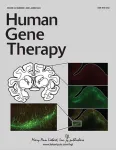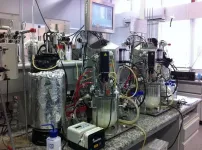(Press-News.org) ITHACA, N.Y. – An international team of astronomers has found the atmospheric compositions of giant planets out in the galaxy do not fit our own solar system trend.
Using NASA’s James Webb Space Telescope (JWST), the researchers discovered that the atmosphere of exoplanet HD149026b, a ‘hot Jupiter’ orbiting a star comparable to our sun, is super-abundant in the heavier elements carbon and oxygen – far above what scientists would expect for a planet of its mass.
These findings, published in “High atmospheric metal enrichment for a Saturn-mass planet” in Nature on March 27, provide insight into planet formation.
“It appears that every giant planet is different, and we’re starting to see those differences thanks to JWST,” said Jonathan Lunine, professor in the physical sciences at Cornell University and co-author of the study.
The giant planets of our solar system exhibit a nearly perfect correlation between both overall composition and atmospheric composition and mass, said Jacob Bean, professor of astronomy and astrophysics at the University of Chicago and lead author of the paper. Extrasolar planets show a much greater diversity of overall compositions, but scientists didn’t know how varied their atmospheric compositions are, until this analysis of HD149026b – also known as Smertrios.
Smertrios is super-enriched compared to its mass, Lunine said: “It’s the mass of Saturn, but its atmosphere seems to have as much as 27 times the amount of heavy elements relative to its hydrogen and helium that we find in Saturn.”
This ratio, called metallicity – even though it includes many elements that are not metals – is useful for comparing a planet to its home star, or other planets in its system, Lunine said. Smertrios is the only planet known in this particular planetary system.
Another key measurement is the ratio of carbon to oxygen in a planet’s atmosphere, which reveals the “recipe” of original solids in a planetary system, Lunine said. For Smertrios, it’s about 0.84 – higher than in our solar system. In our sun, it’s a bit more than one carbon for every two oxygen atoms (0.55).
While an abundance of carbon might seem favorable for chances of life, a high carbon to oxygen ratio actually means less water on a planet or in a planetary system – a problem for life as we know it.
Smertrios is an interesting first case of atmospheric composition for this particular study, said Lunine, who has plans in place to observe five more giant exoplanets in the coming year using JWST. Many more observations are needed before astronomers can discover any patterns among giant planets or in systems with multiple giant planets or terrestrial planets to the compositional diversity astronomers are beginning to document.
“The origin of this diversity is a fundamental mystery in our understanding of planet formation,” Bean said. “Our hope is that further atmospheric observations of extrasolar planets with JWST will quantify this diversity better and yield constraints on more complex trends that might exist.”
The study was supported by NASA and the University of Chicago.
For additional information, see this Cornell Chronicle story.
Cornell University has dedicated television and audio studios available for media interviews.
-30-
END
JWST confirms giant planet atmospheres vary widely
2023-03-27
ELSE PRESS RELEASES FROM THIS DATE:
Breakthrough Brain Imaging: Experts use new microscope, AI algorithm, and voltage indicators to image electrical activity deep in the brain
2023-03-27
When studying the brain, researchers are just beginning to use a method known as voltage imaging to track neural activity in the living animal. While this approach is a promising way to better understand neuron firing, behavior, and cognition, there are limitations and risk factors. The practice requires putting a lot of light into the brain (which can lead to overheating) and only has the capacity to image ten neurons at a time.
New research from Jerry Chen, a Boston University College of Arts & Sciences assistant professor of biology, and collaborators aims to address these challenges. Published today in Nature Methods, ...
RIT researcher receives funding to improve infrastructure safety for nuclear waste disposal
2023-03-27
Researchers at Rochester Institute of Technology are investigating the combined physical effects of heat, chemical reactions, and seismic activity on concrete lining structures used to dispose of nuclear waste. Results from the work could improve nuclear waste infrastructure designs, better long-term safety management, and refine strategies to meet climate change targets.
Lu Sun, a professor in RIT’s College of Engineering Technology (CET), received a grant of nearly $500,000 from the Nuclear Regulatory Commission for “High temperature and seismic response of concrete lining structures and clay in nuclear waste disposal.” ...
NASA’s Webb measures the temperature of a rocky exoplanet
2023-03-27
An international team of researchers has used NASA’s James Webb Space Telescope to measure the temperature of the rocky exoplanet TRAPPIST-1 b. The measurement is based on the planet’s thermal emission: heat energy given off in the form of infrared light detected by Webb’s Mid-Infrared Instrument (MIRI). The result indicates that the planet’s dayside has a temperature of about 500 kelvins (roughly 450 degrees Fahrenheit) and suggests that it has no significant atmosphere.
This is the first detection of any form of light emitted by an exoplanet as small and as cool as the rocky planets in our own solar system. The result ...
Benefiting from orphan drug and rare pediatric disease designations for gene therapy
2023-03-27
Providing an overview of the submissions process and examples of U.S. Food and Drug Administration (FDA) applications for Orphan Drug Designation (ODD) and Rare Pediatric Disease Designation (RPDD), a new article can help developers of gene therapies for rare genetic diseases. The article is published in the peer-reviewed journal Human Gene Therapy. Click here to read the article now.
Anne Pariser and Elizabeth Ottinger, from the National Center for Advances in Translational Sciences (NCATS), National Institutes of Health, and coauthors, describe the ODD and RPDD programs, which provide financial incentives for the development of ...
Study paves way to more efficient production of 2G ethanol using specially modified yeast strain
2023-03-27
A Brazilian study paves the way to increased efficiency of second-generation (2G) ethanol production based on the discovery of novel targets for metabolic engineering in a more robust strain of industrial yeast. An article on the study is published in the journal Scientific Reports.
The databases compiled by the authors are at the disposal of the scientific community in the repository of the State University of Campinas (UNICAMP), which is a member of the Dataverse Project, an international collaborative initiative supported by FAPESP.
First-generation (1G) ethanol is produced from sources rich in carbohydrates ...
UC Davis Health collaborates with Propeller Health to improve clinical outcomes of COPD patients
2023-03-27
UC Davis Health and Propeller Health have announced a new collaboration that will offer personalized treatment for high-risk patients with asthma and chronic obstructive pulmonary disease (COPD) aiming to improve their health outcomes.
As part of the collaboration, UC Davis Health will provide the Propeller program – including sensors, mobile app, web portal, and personalized support – to eligible patients, with eventual expansion to patients in other UC locations and UC affiliates. The sensors attach to a patient’s inhaler to capture unique signals that record events, such as ...
Largest study to date of minipuberty identifies two new patterns of the reproductive hormone, AMH, in infant girls
2023-03-27
Minipuberty is a stage of reproductive development during infancy in both sexes when reproductive hormones change and reproductive organs develop. The importance of minipuberty is not well understood but could represent an opportunity for the early identification of future reproductive conditions and enable prompt treatment. Anti-Müllerian hormone (AMH) is one of the hormones that changes during minipuberty, and it plays a key role in the development of reproductive organs in boys. However, the role of AMH in infant girls is less clear.
In ...
Bomb-sniffing rodents undergo ‘unusual’ reproductive transformations
2023-03-27
ITHACA, N.Y. – Female giant African pouched rats, used for sniffing out landmines and detecting tuberculosis, can undergo astounding reproductive organ transformations, according to a new study.
The paper, “Extreme plasticity of reproductive state in a female rodent,” which published March 27 in Current Biology, explores how traits once considered “fixed” in adult animals may become variable under specific pressures.
Though these rodents could have important military, biodetection and humanitarian uses, breeding them at high rates has been a challenge. ...
ENGOT-EN6-NSGO/GOG-3031/RUBY trial results: The new standard of care in advanced/recurrent endometrial cancer
2023-03-27
EMBARGO DATE: Monday, March 27, 2023, 12:30 pm ET
PRESS RELEASE
ENGOT-EN6-NSGO/GOG-3031/RUBY trial results:
The new standard of care in advanced/recurrent endometrial cancer
ENGOT, NSGO-CTU & GOG-Foundation proudly announce the ground-breaking results of ENGOT-EN6-NSGO/GOG-3031/RUBY trial.
The results reveal improvement in overall survival at 24 months in whole study population from 56% (CP+placebo) to 71.3% (CP+dostarlimab). “although these are interim data, we believe they are robust and will be confirmed with longer follow-up.”, said Mansoor R Mirza.
The trial is presented on 27th of March 2023 through ESMO’s ...
Human body a breeding ground for antimicrobial resistance genes
2023-03-27
The community of microbes living in and on our bodies may be acting as a reservoir for antibiotic resistance, according to new research from the Earlham Institute and Quadram Institute in Norwich.
The use of antibiotics leads to ‘collateral damage’ to the microbiome, ramping0 up the number of resistance genes being passed back and forth between strains in the microbiome.
The findings also suggest these genes spread so easily through a population that, regardless of your own health and habits, the number of resistance genes in your gut is heavily influenced by national trends in antibiotic consumption.
The rise of antimicrobial resistance (AMR) among human pathogens is widely seen ...




